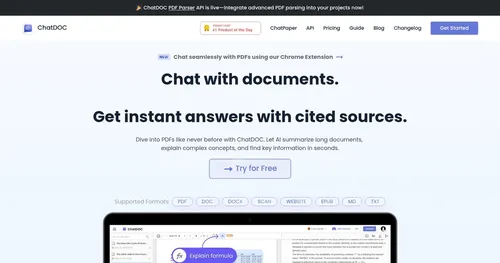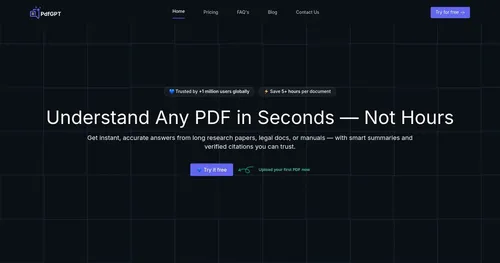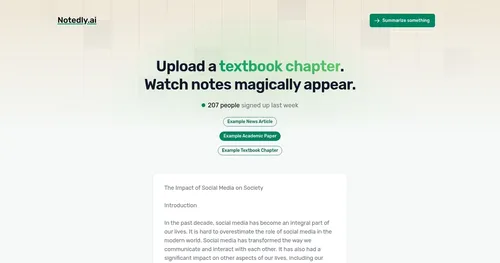Papermark AI
Papermark AI is an open-source platform for secure document sharing, real-time analytics, and AI-powered document interaction, designed as an alternative to DocSend. It enables users to share documents like pitch decks and PDFs with customizable permissions, track engagement with page-by-page analytics, and use AI to summarize content, answer questions, or generate investment memos. The platform uses AES-256 encryption for security and supports custom domains for branded sharing. It’s free to use with basic features, with paid plans for advanced functionality.
Key features include secure sharing, where users can set permissions and revoke access anytime. Real-time analytics provide detailed insights into viewer behavior, such as time spent on each page. The AI assistant allows users to interact with documents, offering summaries and contextual answers based on uploaded content. The open-source nature enables self-hosting and customization, appealing to developers and privacy-conscious users. Papermark AI supports various document types, including pitch decks, sales decks, and PDFs, making it versatile for professional use.
Compared to competitors like DocSend and PandaDoc, Papermark AI stands out for its open-source model and affordability. DocSend offers robust integrations with CRM tools, which Papermark lacks, while PandaDoc provides more advanced e-signature and workflow automation features. However, Papermark’s AI capabilities, such as document comparison and memo generation, give it an edge for users prioritizing interactivity and analytics over integrations.
Some users may find the platform’s AI summarization less reliable with complex or chart-heavy documents, as noted in reviews across the Internet. The self-hosting option, while powerful, requires technical expertise, which could deter non-technical users. The interface is user-friendly but lacks the polish of proprietary platforms. Community feedback on X highlights the platform’s potential, with users appreciating its transparency and frequent updates.
To get started, sign up for a free account and upload a document to test the sharing and analytics features. Experiment with the AI assistant by asking specific questions about your content. If you’re comfortable with technical setups, explore the self-hosting option via GitHub for full control. Lastly, you’ll want to monitor the platform’s community for new features and improvements.
What are the key features? ⭐
- Secure Sharing: Control access and revoke permissions anytime for shared documents.
- Real-Time Analytics: Track document engagement with detailed page-by-page insights.
- AI-Powered Assistant: Chat with documents, generate summaries, and create investment memos.
- Custom Domain Support: Use your own domain for a branded document-sharing experience.
- Open-Source Flexibility: Self-host and customize the platform to meet specific needs.
Who is it for? 🤔
Examples of what you can use it for 💭
- Startup Founder: Shares a pitch deck with investors and uses AI to summarize feedback.
- Sales Professional: Tracks client engagement with sales decks via real-time analytics.
- Investor: Chats with received pitch decks to quickly extract key information.
- Researcher: Builds a knowledge base by summarizing and querying uploaded PDFs.
- Developer: Self-hosts Papermark AI to customize document-sharing for a team.
Pros & Cons ⚖️
- AI-driven document interaction.
- Open-source and customizable.
- Free tier for basic use.
- AI can struggle with complex PDFs.
- Self-hosting requires technical skills.
FAQs 💬
Related tools ↙️
-
Summarist.ai Generates concise book summaries using advanced AI technology
-
 ChatDOC
AI based file-reading assistant that can quickly extract, locate, and summarize info from documents
ChatDOC
AI based file-reading assistant that can quickly extract, locate, and summarize info from documents
-
 PdfGPT.IO
Chat with PDF documents, ask questions and get meaningful answers
PdfGPT.IO
Chat with PDF documents, ask questions and get meaningful answers
-
 TaxGPT
Streamlines tax research and automates workflows for tax professionals with AI precision
TaxGPT
Streamlines tax research and automates workflows for tax professionals with AI precision
-
 Notedly
Automatic notes generation from longer texts like scientific publications, textbooks, and more
Notedly
Automatic notes generation from longer texts like scientific publications, textbooks, and more
-
TubeOnAI Summarizes videos, podcasts, and documents into concise insights

